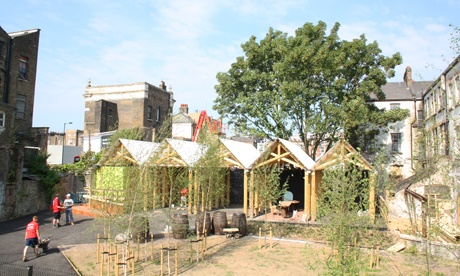From the Mill to the Barn

The wasteland occupied last year by the Dalston Mill and wheatfield is now being used for the Dalston Garden and barn
Pop-up culture has permeated London’s every reach in recent years, and temporary structures abound in the capital this summer. Some are interesting, some are just an excuse to make a few bob.
But judging by the success of last year’s Dalston Mill, the new Dalston Garden, set to open at 12 noon on Sunday 4 July, will be well worth a visit.
So if you fancy spending a few tranquil moments in a quiet, green space slap bang in the middle of hectic Dalston Junction – soon you’ll be able to do just that.
After a delay due to building works overrunning, the eagerly awaited Dalston Garden will be open as a self-styled ‘meeting place for people and plants.’
Saplings have been planted and wooden barns erected, complete with barrels on their roofs to collect rain to water anything and everything growing in the space.
Once part of the Eastern Curve railway line, it later became overgrown wasteland, but this recently reclaimed space is now just about ready to be used for whatever the people of Dalston decide.
Potentially the area could hold workshops, parties, debates and lectures, a pond or a fountain, gigs, cookery and cocktail classes or dance workshops. These are just some of the suggestions put forward by Dalston residents, and the venue is an ideal spot to engage people with the natural world around them in a laid-back fashion.
Readers may remember that last summer the site was used to grow a recreation of American artist Agnes Denes’s 1982 work, ‘Wheatfield – A Confrontation’, in which a field of golden wheat was planted in wasteground two blocks away from Wall Street in New York’s Manhattan.
This work inspired French architects EXYZT to construct a temporary but fully functional mill on the Dalston Eastern Curve site, as part of the Barbican’s exhibition entitled ‘Radical Nature – Art and Architecture for a Changing Planet 1969-2009’.
The Dalston Mill and its accompanying mini version of Denes’s wheatfield attracted visitors for three weeks in July and August 2009.
Guests baked and sampled bread and pizza made in the mill and partook in a varied programme of events that included a pedal-powered music performance, a cake decorating workshop and African acrobatics.
Local residents responded very positively to the initiative. “We would recommend that the borough of Hackney keep up this wonderful, family-friendly project space,” said one visitor to the Hackney Mill last summer.
In November last year, after consultation with local people, Hackney Council’s Development Masterplan for Dalston established that public open space was lacking here – especially green space.
Official efforts to overcome this problem have so far met with mixed success. The revamped Gillett Square is certainly far cleaner than it was, and it serves as a convenient location for open-air cultural events, but it has the feel of official public space about it.
Likewise the various bits of greenery wedged in and about the new Dalston Square development are bound up in the architectural strictures of the buildings that surround them.
Not so Dalston Garden, which promises to be a free-form exploration of the multifarious potential of urban planting. The contingency and open-endedness of the project, which brings together a plethora of different local organisations, suggests it has considerable potential to rival last year’s runaway success on this curious site.
After the opening, Dalston Garden will be open every day from 11am until 8pm, with special morning events planned. Look out for the timetable soon to be published. The entrance to the Dalston Garden is through the wooden gate is by the peace mural on Dalston Lane, just opposite the new overground station.
More information:
Dalston Garden
tellme@dalstongarden.com
020 7503 1386
Related story:

Great to have this just around the corner. Does anyone know how long this will be there?
Yes – it’s a permanent fixture.